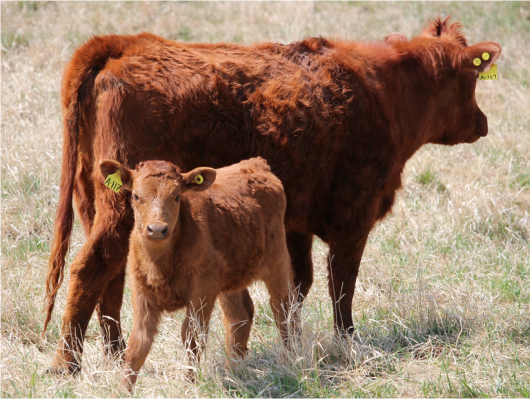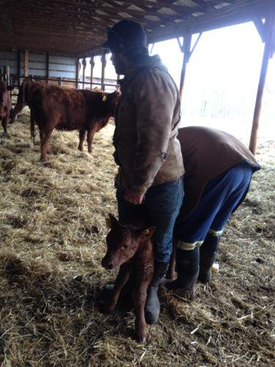|
Posted By: Jesse Williams
I have had a lot of questions about how we structure our cow/calf management tags in our herd, as I have posted a few pictures of making tags and our DIY Tag Board, that seemed to confuse people. This leads me to believe we must be doing things rather different than anyone else (which could be a good or a bad thing) and so I thought I would take a few minutes to share what we do and why. I would LOVE to hear how you do management tags on your operation because there is always room for improvement!
The International Standard
We do follow the international tag lettering system for our COWS. This handy dandy little system gives your cows a letter for their tag that corresponds with the year they were born. This is super convenient when buying cows at the auction mart- IF (and I stress, IF) the previous owner follows that same international standard. I am learning more every day that there are less and less people following it, which I always ask myself 'Why not?'. If you have any insight into that, please let me know!
Cow Tags
As mentioned above, we give all cows their letter corresponding to their year of birth, followed by a management number. We simply started at 100 when we began our herd. This is because we have very similar cows to our family members, who we also sometimes run in the same pastures or management groups. By starting all our numbers in the 100's, (their's start in the single digits), we can easily identify whose cow is whose.
We also use a different colored tag for every year of birth. This is simply another aid to allow us to identify a cow at a quick glance. Sometimes you may only be able to see the number on the tag because of long hair, but if its orange you know that is likely a 'B' cow, for example. It is probably over kill (and does make for a LOT of extra tags always hanging around in every color) but it does work well for us.
Reusing Tags & Saving Money
In order to save a bit of money we reuse the same calf tags every single year. At weaning we cut the button off the back of each tag, saving the tag for the next calf crop. We do this when the calves are in the chute ready to load onto the liner to the auction mart. We simply lean over the chute with a tag cutter and remove the tags. Now this is easier said than done and I'll be the first to admit it. In previous years we had an old rickety chute that had bars across the top. Those bars were just in the right spot to bonk your head when you weren't paying attention. We do have a better chute now, but it is still somewhat inconvenient and been a topic of discussion in our house for some time. I guess the cheap side of us won over because we are still doing it!
After weaning, we take the tags in the house, wash them in soapy water to remove any old dirt and use a knife or pen to pop out what's left of the old button. We then use a tag pen to trace over the existing letter and number to make sure it is vibrant and readable for the next year.
Economics on reusing tags:
*These are the actual costs of tags and buttons we purchased in 2015. Tax not included. Large Allflex 2 piece tags/buttons: $30.44/ 25 tags & buttons ($1.22/head) Allflex buttons: $14.59/ 25 buttons ($0.58/head) Savings: $15.85/ 25 head ($0.63/head) For a herd that produces 100 head of calves continuously, you would be saving $63.40 per year (or $0.63/head). Now that doesn't sound much, and it really isn't, but 63 bucks is 63 bucks in my opinion. My father in law loves to say that when you are young, you trade work to save money, and when you are old you trade money to save work. Clay and I are still young so I think we will continue to take the extra few minutes to remove tags, wash them and reuse them each year, at least for now. Note: We have a very low tag loss rate in calves. In 100 head, we might lose one per year, if that. Pros/Cons of Our Tagging System This yearling got it's old tag removed when she became a permanent part of our herd. The A corresponds to her year of birth in 2013. This yearling got it's old tag removed when she became a permanent part of our herd. The A corresponds to her year of birth in 2013.
While this is the way the hubs' family has been doing it for years, my number one concern when I was introduced to it was the increase in time/work to tag replacements twice, plus the stress of two tagging steps for replacements, or the removal of the tags for calves going to market. They have to be tagged at some point in their life, but the second tagging for replacements is usually done in the chute when the heifers are receiving annual vaccinations. And because we use the same hole that their original tag was in, I think the stress is fairly limited.
For the calves being sold to market, I think it would be fair to say there is some stress on weaning day and adding an additional few minutes in the chute trying to wrangle a tag out of their ear likely adds to it. However, I don't know how much stress or how much shrink that would equate to, and if it would be enough to cancel out the savings from reusing tags. The other option I see a lot of producers use is to tag at branding rather than at birth. I am not particularly fond of this method just because it is hard enough to know which calf goes with which mother when they have corresponding tags. Without tags for a few months before branding would always make me worry I have the wrong calve/cows matched up. This would wreak havoc on my record keeping system as my data would no longer be reliable. If a cow lost her calf and adopted another (which most certainly happens), and I use the adopted calf's data as that cow's progeny, I could have very skewed results as to the genetic characteristics that mother throws.
At the end of the day, this is how we've been using management tags in our herd. It may or may not work for you herd but we sure would love to hear how your system might differ. Leave a comment or send us an email!
1 Comment
4/30/2019 10:58:30 am
I like how you explained that calf tagging systems should be able to identify which calves belong to which cow. My husband and I recently bought some rural property and have discussed the idea of buying some cattle soon. I'm glad I read your article because now I know what features to look for as we search for cattle to buy.
Reply
Your comment will be posted after it is approved.
Leave a Reply. |
A Blog About Our Life, Love & Lessons Learned on the Ranch
Categories
All
in the mediaArchives
February 2024
|





